Photo
I remember the subs putting the events 15 years before the present day, which would imply Mafune was disgraced for quackery AFTER Godzilla had already attacked.


I would really like to know the full context of what started off the full physical tussle between younger Mafune and the army of old science dudes
193 notes
·
View notes
Text
Funnily enough I made a graph plotting the James Bond and Godzilla series last year.

The Bond films tend to have more gradual but regular releases, whereas Godzilla has long breaks but will more often do yearly entries when active. The closest they came to tying was in 1989, after a nearly unbroken 14 year lull in Godzilla, but Biollante spoiled their chance. After that they went on a pause just as the Heisei series kicked off. Even with the 12 year hiatus and slow release of mainline Reiwa entries, they didn't pump out enough Daniel Craig films to catch up (and considering how sick of the character he was by the end I doubt they could have).

A then-current list of Godzilla films in the Prima strategy guide for Godzilla: Destroy All Monsters Melee. Pretty good until it gets to the Millennium series; I'm especially grateful we weren't subjected to Godzilla vs. Mechagodzilla III.
29 notes
·
View notes
Text
The Lost World (1925) turns 100

It's been a century since the first adaptation of Sir Arthur Conan Doyle's original novel. This movie holds a special place for me as the first silent film and vintage monster movie I ever saw.

I first learned about the movie from a museum exhibit on Charles R. Knight, and it's easy to see why it was highlighted. More than any other dinosaur film this feels like one of his paintings in motion. Willis O' Brian set the standard for active dinosaurs in film: Sauropods stampede across dry land, while theropods leap onto and grapple their prey. He and his protege Ray Harryhausen would expand on and refine this dynamic portrayal throughout their careers, going against the contemporary scientists' and even Charles R. Knight's characterization of dinosaurs as sluggish, ungainly animals.

Sadly O' Brien's later work did not carry on the Lost World's depiction of dinosaurs as living animals rather than perpetually bloodthirsty monsters. Much of the movie's extensive stop motion is dedicated to dinosaurs going about their business, living in families, hunting or browsing, only occasionally interacting with our human leads. Very few films have the ambition to depict a full on prehistoric ecosystem. It's by no means devoid of sensationalism: the carnivores have a habit of attacking other animals with food already available or losing their meals like klutzes. Still, it took a long time for other films to even differentiate herbivorous dinosaurs from meat eaters.

Even modern dinosaur movies could learn a thing or two about how The Lost World treats its herbivores: while they rarely start fights, they are more than capable of finishing them. Instead of passive meals, the prey animals are often able to repel and even kill their predators, fighting back with a vicious desperation rarely see in movies but all too common in the natural world. This more balanced approach is a breath of fresh air compared to the theropod fixation common in modern palaeomedia.

Modern big budget dinosaur movies could also learn from The Lost World's restraint. The problem with using Tyrannosaurus rex as the baseline Big Theropod is there is nowhere to escalate without pulling things out of your ass (see the Jurassic World movies). T. rex was essentially the final boss of non-avian theropods; while a few other theropods may have matched or slightly exceeded it in length, none were as heavily built, none had such a strong bite, and none combined it with the Tyrannosaurids' impressive suite of senses and intelligence. Tyrannosaurus was described only 20 years prior to the Lost World film, which opts to use the more established Allosaurus as the main saurian antagonist, but highlights the more impressive newcomer during a few key scenes. I often wish T. rex could have remained this seldom seen novelty rather than becoming a tired old measuring stick.

Most relevant to my usual focus, The Lost World is—to my knowledge—the first film to depict a giant monster rampaging through a city. The Brontosaur's frenzied escape from London prefigures much of King Kong's final act (though with a less tragic end), and O' Brien's miniature work holds up pretty well. Even now the large sauropod stands out compared to the giant apes, theropods, and other more fanciful usual suspects.
youtube
The film is in public domain, and various versions are available on Youtube if you want to watch. Today was my first time watching the most complete version from 2016, but my favorite version is still the slightly shorter Image Entertainment release with the Alloy Orchestra soundtrack. It's missing a few scenes, but I enjoy the moodier atmosphere provided by the contemporary score, and the subtler color tints—the purple caves in the newer version are a strange choice, even if they are apparently more authentic. It also has much less caricatured dialog for the character Zambo: whether or not the newer intertitles are more accurate to the original script, it makes his scenes even harder to stomach than the use of blackface already was.
#dinosaur#dinosaur film#brontosaurus#agathaumas#tyrannosaurus#triceratops#allosaurus#ape man#pterodactyl#trachodon#stegosaurus#brachiosaurus#the lost world
4 notes
·
View notes
Text
I wonder why KiryuGoji and FinalGoji didn't get their own vignettes if they're in the final shot.


The finale of Tokyo GODZILLAs (2024), bringing together suitmation and CGI versions of the Monster King (plus Chibi Godzilla).
1K notes
·
View notes
Text




I find it funny how often "random giant walrus attacks out of nowhere" happens across various media.
#kaiju#kaiju eiga#kaiju tv#monster#monster movie#wolf#wolf anime#maguma#todola#giant walrus#sea creature#hige#toboe#walrus
3 notes
·
View notes
Text
Atomic Breath Through the Years
Starting the new year with another addendum to my Godzilla film watch. Here are my thoughts on Godzilla's Atomic Breath, how it's changed over time, and its use within the narrative. Credit to Wikizilla and Toho Kingdom for images, and to the Universo Godzilla Youtube channel: their atomic breath compilations were a major help in refreshing my memory.
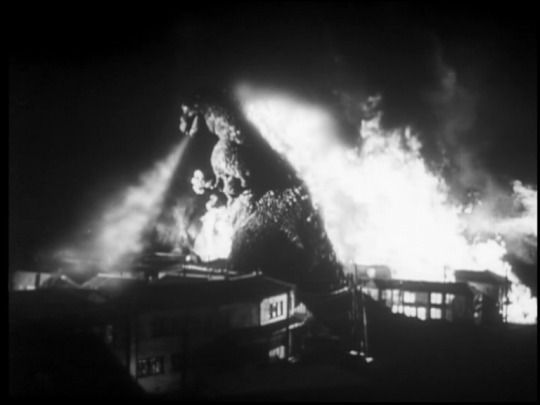
Fire Unextinguisher (1954-1964) Godzilla's breath weapon starts out fairly modestly. This unfocused blast of white/blue hot radiation lacks the explosive punch of later variations, but its intense heat can still melt steel structures and set buildings and forest ablaze. In the original film this is more than sufficient to lay waste to Tokyo, but against other monsters it's rarely more than an annoyance. Its most bizarre feat was deflating several rock formations shielding the Mothra Larva: I don't even want to contemplate the power required to do that.
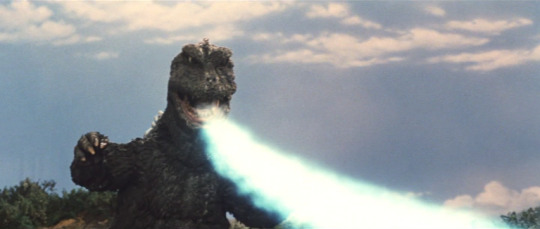
Angry Blue Cloud (1965-1975) Atomic Breath underwent a lot of minor changes through the Showa era, but I've landed on Invasion of the Astro Monster as a key turning point: absent the practical mist sprayer, the heat ray is animated directly striking its targets rather than washing over them, providing some actual impact. It still remains a relatively weak incendiary weapon in Astro Monster: the licks of fire it produces in the woods aren't even as impressive as the big gouts of flame in King Kong vs Godzilla. However, it becomes more effective against other monsters in Fukuda's island duology, even getting a few kills. From Destroy All Monsters on it becomes much more kinetic, blowing buildings to smithereens and connecting with kaiju in a satisfying spray of sparks. It still remains only one of Godzillas tools though: it can hurt other monsters, but rarely delivers the finishing blow. It does have a lot of versatility, ranging from a narrow stream to a thick spray, flying straight or curving upward, activating electrodes and of course, lifting Godzilla off the ground.
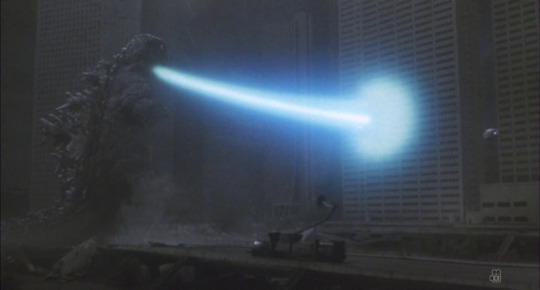
Concentric Cones (1984) Return of Godzilla is the first atomic breath I would describe as an actual "heat ray". Even late in the Showa era, it was still more reminiscent of radioactive dragonfire, with frayed boundaries and somewhat limited range. Here the breath has become a highly concentrated beam of energy, with smooth edges flanked by an even glow. Its effects on the environment remain quite explosive, but it is now capable of punching through softer targets instead of immediately dumping all its energy. More gruesomely, it is one of the few times we see its direct effects on humans. Like the Godzilla that fires it, it's a bit of an outlier compared to the rest of the Heisei series. It retains a bit of an upward curve from the Showa series, and has much less detail than in following films. The latter often results in an underwhelming appearance, particularly when the white core is particularly narrow. It arguably fails to match some of the more intricate Showa examples, with their complex, fiery forms.
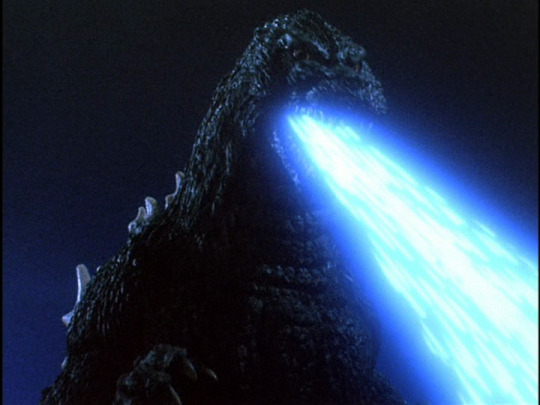
Spark Dispenser (1989-1995) Kawakita's team brought back much needed dynamic complexity to the heat ray effects by replacing the uniform beam with a rougher conglomeration of linear bolts. There's something satisfyingly chaotic about the choppy frame by frame animation and the way Godzilla walks the beam onto target. This chaos is then grounded by the practical light up dorsal plates, and the impressive explosive squibs used to demonstrate its impact on target environment (even if those squibs are increasingly composed of sparks). It's a good thing the beam is so aesthetically pleasing, because you'll see it countless times by the end of the series. Heisei Godzilla is a primarily ranged fighter, but with only slightly improved damage against other kaiju, his battles end up a bit sloggy. It's likely a big part of the introduction of the Red Spiral Ray, to give Godzilla a more dramatic means of finishing fights than chipping away with repetitive blue beams. The spiral ray itself is an interesting addition: it's ironic that the more powerful beam has a colder burning hue, but alongside the nuclear pulse adds a bit of variety to the abilities of this less athletic Godzilla, and its good shorthand for how powerful he has become when it becomes the standard in his burning form.
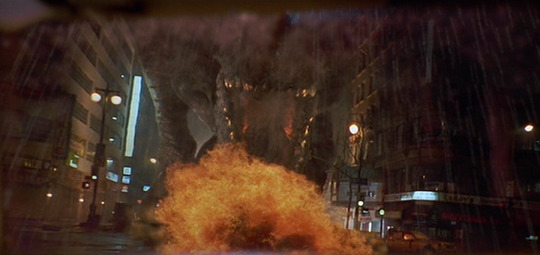
Bad Breath (1998) Its funny how this glorified burp was made flammable as last ditch effort to appeal to fans; they shouldn't have bothered considering the film's more severe issues. Ironically the effects aren't too far removed from the earliest versions of the attack: a misty spray that causes things to catch fire.

Sunny D (1999-2000) The first proper CGI heat ray set the pattern for the rest of the Millenium Series, both in aesthetic and in usage. For the first time we see the breath build up in Godzilla's mouth, while the still coherent beam now has dynamic, fiery borders. The orange color of this iteration remains unique; it works well enough within the films, but I think it's a bit too reminiscent of more mundane fire breath. Narratively, this beam is a bit closer to the similarly colored spiral ray: Godzilla uses it less frequently, but when he does, the opposing monster is heavily maimed or even outright killed. Were it not for Orga's rapid regeneration or Megaguirus's energy absorption and massive speed advantage, their respective fights would have ended far sooner.
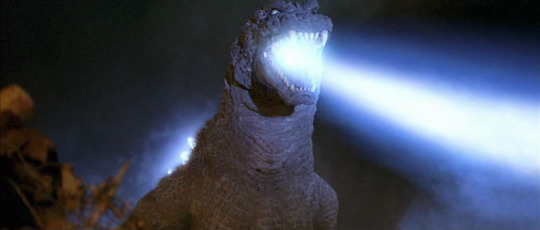
Thunderball (2001) Unfortunately this atomic breath never quite lives up to its explosive introduction, settling for destroyed buildings and cliff faces for the rest of the film. I'm not sure if it's the simpler charge effects, the less detailed beam, or even just the narrower width, but GMK's atomic breath never felt as satisfying as the other Millenium incarnations. It at least retains their dramatic power vs other kaiju: every time Godzilla tags a Guardian Monster they are out for the count. I think it fits here: Godzilla is an all powerful antagonist who must be defeated by the combined efforts of the plucky underdogs.
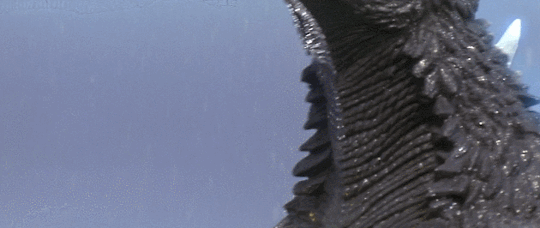
Final Form (2002-2003) The visual peak of the "bulky beam" style of atomic breath established in the Heisei series. I love how it begins with random dorsal plate flickers like an ignition start, as well as the expanding bubble of energy in the mouth that bursts just as the ray is released. The beam itself combines the ragged yet substantial form of MireGoji with the classic blue hue, better distinguishing it from ordinary flame. It strikes a balance against other Kaiju, remaining narratively significant upon impact, while refraining from the all powerful finisher status of other Millenium examples. It's telling that the modern entries have taken the breath weapon in different directions: it's hard to improve on perfection.

Super Cyan (2004) This beam barely distinguishes itself visually from the prior example, switching to a slightly greener hue and more uniform dorsal flicker. Unfortunately its narrative role is closer to an Ultraman beam (or Shonen energy wave), switching between superficial damage and obliteration of foes depending on the enemy's nebulous power level and proximity to the end of the fight. The physical effects are equally arbitrary—another element borrowed from Shonen battle manga. The environmental destruction is generally the same as before, but the attack will randomly launch massive kaiju high into the air, or generate a massive explosion during a brief beam lock. The brief return of the Red Spiral Ray is little more than fanservice: the basic blue beam is already plenty overpowered. Like the Godzilla that breaths it, I just don't think this suits the character in a protagonist role.
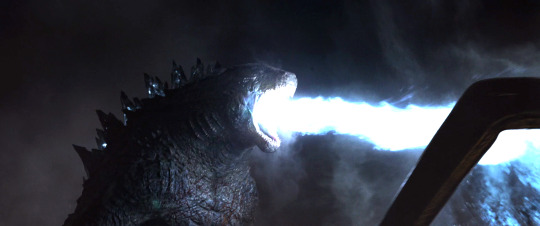
Blue Flame (2014-2019) Seeing that first buildup in theaters was sublime in theaters. Gareth Edwards holds off for long enough that you've almost forgotten, then promptly reminds you by bathing the frame in blue. The glow steadily creeping up the dorsal plates is such an inspired choice for building anticipation, and I like the more subtle way the light seeps from cracks in the plates. I have to admit I was underwhelmed by the actual atomic breath. I appreciate the organic, naturalistic feel, and enjoy the throwback to the Showa beams' fiery nature, but the visual appearance feels a tad underpowered for such a big, burly Godzilla. I think the more substantial flame introduced in King of the Monsters was a good compromise, though I wish they had stuck with the naturalistic dorsal glow instead of adding more light to the eyes and neck. It takes further inspiration from the Showa era's narrative use. Legendary Godzilla is more of a brawler, rarely using his ranged weapon. When it is fired, the blast rarely does more than knocking other kaiju off their feet, but can be deadly in circumstances like the iconic Kiss of Death.

Cabinet Resignation Beam (2016) Keeping the audience in the shoes of the protagonists, Shin Godzilla debuts a whole new form of atomic breath. Anno plays with expectations by having Godzilla breath actual fire, before narrowing the massive conflagration down to a thin, violet scalpel that slices through all obstacles with no noticeable delay. I love all the little touches—the way the red patches shift to purple, the unnerving split jaw, the mirrored protective eyelids, and the way the beam only becomes visible past the focal point. The color is a bold choice: this heat ray is no longer just hot, it is emitting high energy photons that are creeping off the visible light spectrum. Anno also massively expands Godzilla's versatility of ranged attacks, giving it the ability fire the same beams from its back and tail. I really appreciate that it does the most damage with the fire breath, setting the whole city ablaze in a way calls back to both the original film, and the Tokyo firebombing that influenced it.

Nose Ray (2017-2018) What AniGoji's design cribbed from 2014, its beam cribbed from Shin. The conceit of the heat ray being an extension of an electromagnetic field rather than an actual breath weapon is interesting in theory, but as Godzilla only fires it from the head area it's not taken advantage of. I also have some misgivings about the beam being purely electric instead of radioactive: I feel like Godzilla should aways retain a nuclear nature to some degree. Godzilla Earth's other additions are pretty mixed: the Super Oscillatory Wave is just a weaker breath weapon, while the Plasma Cutter seems weirdly overpowered compared to the stated output of the other weapons.
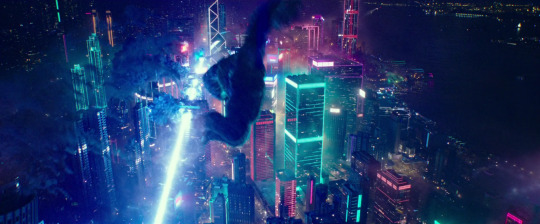
Having Your Yellowcake and Eating It (2021-2024) For Godzilla vs Kong, Wingard claimed to use versions of the titular characters familiar to audiences, but that certainly didn't apply to the top biller's breath weapon. Godzilla's fiery hammer somehow serves as an even more precise scalpel than Shin Godzilla: it slices clean through buildings while leaving adjacent comic relief unscathed, and tunnels into the Hollow Earth with barely a whiff of the miles of molten rock it would have to displace. The energy required for that little trick would make the following entry look like a firecracker, yet the following fight with Kong leaves Hong Kong largely intact beyond some neatly trimmed skyscrapers and baffling blue explosions. I personally feel the power of kaiju should be consistently apparent in their battles, but Wingard's primary decision process seems to revolve around "wouldn't it be cool if...". This chafes against the naturalistic tone of the early Monsterverse films, as do the visual choices. The extra glow from King of the Monsters has crept all over Godzilla's body, and he spams the beam so much that he ends up a gaudy neon mess for a good chunk of the fights. I'm also heavily against the implication that the "atomic" breath is some mystical Hollow Earth energy, or "quantum states" as in the novelization: it sanitizes the character by fictionalizing his power source into something safely detached from real world context or commentary.
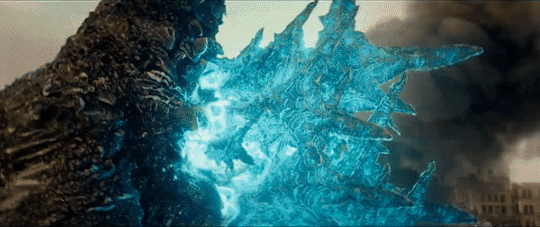
Never Say Never Again (2023) This is the most powerful that Godzilla's Atomic Breath has ever appeared. You can cherry pick higher numbers for certain incarnations, but none are as consistently devastating as MaiGoji's nuclear fire. The cooldown period keeps the beam's usage in check, while the buildup is a wonderful twist on the Monsterverse formula, combining the gradual upwards creep with the rising dorsal plates, which slam down like control rods upon firing. The result is a repeatable GMK seen from the ground level; all the destruction of Shin Godzilla is unleashed in a single instant; for the first time, Godzilla truly embodies his origin. The moment that shocked me the most in theaters was before the fireball, when the surrounding buildings were pulverized without being hit: all the energy of an atomic bomb has been spewed in a general direction, interacting with its surroundings without constraint.
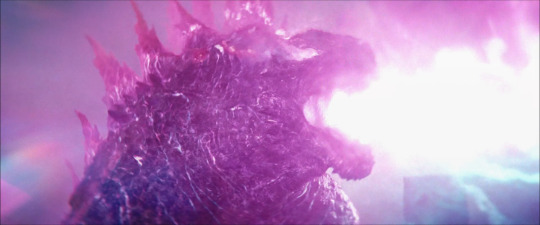
Color Out of Place (2024) All the problems under Wingard continue in Godzilla's evolved form. The unnatural neon glow is even more amplified. The wispy pink beam lightsabers through a 200 meter thick mountain of limestone, while the neon lightshow gets even further exaggerated. My biggest issue is with the new color though. Pink/magenta hues do not correspond to actual spectral wavelengths, they require a mixture of red and violet light to occur. Many films use these composite colors in artificial lighting to create an uncanny atmosphere. While a pinkish glow may work well for mystical or otherworldly kaiju, I would argue it is a poor fit for the grounded guardian of nature the Monsterverse Godzilla was originally established as. It doesn't help that it contrasts poorly with many of the environments it is used in, often coming across as garish. Perhaps the biggest missed opportunity occurs during the Hollow Earth scuffle though. Despite the Zero-G environment, the hypothetical increase in power, and the sillier tone, at no point does Godzilla use his atomic breath to maneuver in microgravity. What is the point of throwing realism out the window if you don't get creative with it?
17 notes
·
View notes
Text
Godzilla Design Runway: Monsterverse/Reiwa
Finishing up the runway with the designs from both ongoing "eras". I was partly inspired to do this sub-series by the Monster Suit Database on Kaijubattle.net, as well as the Godzilla Designs by Year from Becominggodzilla.com. Photos Sourced from Wikizilla.

Papa Bear (2014) A more holistic attempt at a "realistic" Godzilla than ToraGoji ever was. GareGoji's thick, column like legs and robust, mountainous build successfully sell the concept of an amphibious animal weighing tens of thousands of tonnes, while his crocodilian scales position Godzilla as a natural creature rather than the product of man's arrogance. His angular, weathered appearance also deftly conveys the vast age of this battered old soldier. I do have some issues: the dorsal plates feel a bit to narrow and conical, and the head and neck feel disproportionately small atop the broad chest and shoulders. I think some of the concept models had more appealing proportions in this case.

Tail of a Gorilla Whale (2016) We see very little of ShinGoji's first form so there's not much to dissect. I initially thought this was the same form as Kamata-Kun since there aren't any obvious differences. There are some pretty fun speculative takes on the pre-caudal anatomy though.

Lost Puppy (2016) I think a lot of feelings about Shin Godzilla depend on the ability to stomach Kamata-Kun. This comically awkward, ungainly beast is an outside context problem for both the characters and the audience, but the damage it wreaks as it stumbles forward is very real. Its uncanny, embryonic features also convey it's unnatural origins and ongoing evolution.

Skipped Arm Day (2016) The middle child of ShinGoji's forms, Shinagawa-Kun loses much of ugly cuteness of Kamata-Kun, while still being too awkward to function as a proper Godzilla design. It's important to the narrative, but I find it less interesting than both its predecessor and its successor.

Blistered Kaiju Theater (2016) ShinGoji's most familiar form still manages to be deeply unsettling. Classical features are grotesquely exaggerated: an emaciated upper torso sits atop powerful legs, behind which snakes a lengthy tail with a ragged tip. Keloid scars are joined by open sores across an unnaturally rubbery texture. Countless teeth haphazardly flank a Glasgow grimace, over which the beady eyes betray little emotion. Rather than a natural creature, Kamakura-san sells the idea of an unstable mutating organism roughly forming the image of Godzilla.

Bones Malone and the Spooky Bois (2016) Anno's final kick in the teeth. I love the how the unnerving imagery evokes both an opening seed pod and a disturbed cluster of Harvestmen. The individual humanoids channel Xenomorphs, though I agree with the consensus that it represents Godzilla trying to evolve the communal cooperation that defeated it. I personally enjoy the more literal variant of this interpretation, where these nightmarish figures attempt to overcome humanity through legalistic court battles and bureaucracy.

Filius of Godzilla (2017) The first official anime Godzilla is disappointingly derivative of the more daring 2014 Hollywood design. The head and neck are at least better proportioned, and the treelike traits are interesting in concept, but the anime never elaborates on why a plant would solve into a dinosaur shape. AniGoji's model is also frustratingly unemotive, which worked for ShinGoji, but feels out of place in a naturalistic, yet actively hostile incarnation.

Racist Grandpa (2017-2018) Unfortunately the only design change between the 50m and 300m AniGojis was a scruffy beard of spikes. You'd think there would be more ontogeny and/or allometry involved with such a vast difference in scale. It's not strictly design but I also have to laugh at the ludicrously low mass figure: Godzilla Earth is half the weight of the original Godzilla based Plant Beast, despite being 2.5 times as tall.

Kemono Friends (2017-2018) I wish the Planet of Monsters had more variety. The multiple sets of eyes seem to homage the Ohmu and other insects of the Toxic Jungle, but their otherwise generically dragonish form doesn't hold a candle to Nausicaa's creature design. Their environment is likewise pretty homogenous compared to Miyazaki's forest of fungi; the pedestrian art design reflecting the muddled environmentalist message.

The Lego Piece on Your Floor (2017) A skeletal form brimming with spikes, this Mechagodzilla takes full advantage of CGI to achieve a radical design infeasible in traditional suits. Its abstract face conveys function over form, while it's complex, shifting structure implies its malleable nanometal construction. Unfortunately we don't get to see it in action.

BLAME! at Home (2018) I already knew of Mechagodzilla City long beforehand, so the wasn't much disappointment while watching the film. There certainly isn't much Mechagodzilla in this City though. I do think the "becoming beasts through technology" theme could have been strengthened by having the city start to morph into a giant Godzilla-like form as a last ditch effort to defeat its organic counterpart.

Anime.wav (2018) The worm-type Servum are a bit more interesting than their flying counterparts. I like their lamprey like builds and root manipulation, though the latter appendages seem weirdly disconnected from the main body, and primarily facilitate one of the more embarrassing anime tropes. I also wish these guys got their own name, to better diversify the bestiary.

Pinhead (2019-2024) As KiryuGoji was to MireGoji, DougheGoji is to GareGoji, complete with shrunken head. Since Gary's noggin was already fairly small, this is a bit of an issue for Doughy's proportions. I have mixed feelings about the other changes in design. The more traditional dorsal plates are a great improvement, but the blunted tail tip doesn't convey scale as well, while the spread toes feel like a surrender to the Feet Wars.

Anchor Arms (2021) I wish the largest mobile version of Mechagodzilla wasn't so top heavy. The oversized arms and broad upper torso feel way out of proportion with the stubby neck and skeletal lower body. The changes to Monster Mechagodzilla feel less innovative than they do derivative of other media: its red, spherical eyes and endoskeletal frame draw more from the T800 than they do any of the prior iterations. What references to the original there are end up drowned out: the hint of Space Beam is overwhelmed by the Proton Scream it envelops, while the classic X patterns are lost amongst the busy mechanical design.

The Second to Last Dinosaur (2023) The way that MaiGoji's first form drips with spines and teeth really sells the nightmarish feeling of his attack. His distinct build sells his growth after mutation, though I think his more theropodal head is a tad large for his scale. I almost wish Minus One aimed for a higher classification: its feels dissonant that the ground crew members aren't bitten in half when jaws that large clamp down on them.

Cheek Chub Plus One (2023) The most traditional modern Godzilla design, MaiGoji combines the fearsome countenance and mountainous build of BioGoji with the menacing dorsal plates of MireGoji, breathing life into the old classics with its impressive level of detail. Its thorny hide evokes the naturalistic scales of GareGoji, warped and scarred like the Original: this Godzilla was once a being of nature, but has been irreversibly marred by the depredations of humanity.

Godzilla Rosé (2024) Dispensing with all naturalism, Monsterverse Godzilla evolves into a poorly proportioned mess. Some have read the deeper chest and smaller waist as trans coded, but I liken it more to the difference between a Strongman and a Body Builder; as with his mechanical counterpart, Wingard's Godzilla abandons the sturdy build that grounded the character so well. The prominent rows of spines break up his facial features too much, and the downturned dorsal plates feel like they're wilting. The larger head would be an improvement, were it not for the broader shoulders.
1 note
·
View note
Text
Godzilla Design Runway: Tristar/Millenium
Today I'm covering Godzilla's appearance from the first design to use CGI to the last film to use suitmation. Photos sourced from Wikizilla.

Chinzilla (1998) Ground zero for Raptorization, though his gangly proportions feel closer to a Xenomorph at times. Either way it doesn't suit Godzilla: what works at theropod size doesn't scale up well to a Daikaiju, and ToraGoji lacks the sturdy, pyramidal build that grounds the traditional suits. The design is also awkwardly front heavy, with the forward swept dorsal plates, broad shoulders, and lantern jaw.

Big Head Mode (1998) While giving Godzilla children is usually a way to develop his character, Emmerich seems more invested in aping the raptor scenes from Jurassic Park. As a result the Baby Godzillas are much more vilified than their predecessors, though their menacing features are undercut by their disproportionate, stick-figure builds.

DailyDose (1999-2000) A pretty radical reinvention of the King of the Monsters that still retains the spirit of the character. Channeling KingGoji, the first Millenium suit opts for a more reptilian visage, with its green skin, less upright pose, and crocodilian maw filled with jagged fangs. Its gigantic, crystalline dorsal plates are wholly original, rounding off a unique and iconic package, While it's not my preferred take on the King of the Monsters, I respect it immensely.

ThanksDoc (1999) Orga has one of the more unique builds among kaiju. Its hulking, brutish form is an ironic contrast to its pensive, cautious approach. It's a bit ungainly for my taste, but I can't deny it works in the context of a runaway mutation.

Godzilla Wants the Flamethrower (1999) We see very little of Orga's second phase before it is blown to smithereens. The mouth net is certainly unnerving and I like the rougher skin texture, though it's only a copy of MireGoji's. Ultimately it's more of teaser for further transformation than it is a complete design.

GojiMosuGhidoGoji (2001) The most villainous looking Godzilla design, GMK's squared off muzzle and empty gaze are instantly recognizable. While the more upright stance combined with the neck orientation gives this Godzilla rather poor posture, it helps enhance his menace though his distinct "skulking" silhouette.

Perpetual Perplexion (2002-2003) A solid synthesis of Miregoji's build with more traditional features. While KiryuGoji loses some of the originality of the first Millennium suit, its less fearsome face has unprecedented ability to emote. The amount of animatronics they crammed into that head is impressive: I think the Kiryu Duology may have been where Suitmation peaked at Toho.

Mechagodzilla Unit 03 (2002) While I've come to prefer the original's Tin Can charms, Kiryu was my favorite version for a long time. Instead of sleek futurism or whimsical retrofuturism, Kiryu grounds itself in the Real Robot genre with its detailed, plausible mechanical design. Appropriately resembling both a skeleton and a suit of armor, Kiryu's flexible, organic structure also deserves props for its functioning tail.

MFS-03Z Kai (2003) While its film isn't as good, I actually prefer Modified Kiryu's more streamlined, color-coordinated battle pack and railguns. That said, I miss the Absolute Zero Canon, and while the drill hand is fun, it feels a bit mechanically dubious for an otherwise grounded design.

Absolutely Zero Chill (2004) While the prior Millennium Suits retained surprising mobility given their bulk, the Final Godzilla suit is slimmed down for maximum flexibility and athleticism. Unlike some of its costars, FinalGoji still avoids an overtly humanoid build, instead evoking later Showa suits with extra muscle. It's demeanor is decidedly less Showa: with furrowed brow, piercing glare, and grimacing sneer, FinalGoji looks the most furious of any Godzilla. It's an eclectic mix of features, but impressive nonetheless.

The Relapse (2004) Somehow Minilla returned. While his most displeasing features have been smoothed over, he still resembles a Barney character more than anything Godzilla adjacent. Ultimately the worst version of Godzilla Junior is still more appealing than the best version of Minilla.

Jira Minus D (2004) Fairly embarrassing. While the CGI model's straightened dorsal fins alleviate some of ToraGoji's front-heaviness, this is still ultimately just a lower detail version of the worst Godzilla design.
9 notes
·
View notes
Text
Godzilla Design Runway: Heisei
This time I get to evaluate all the tiny differences between the post-1989 suits. Photos sourced from Wikizilla.
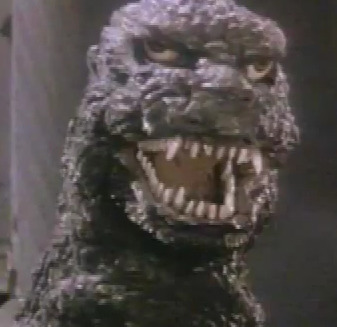
The Odd Duck (1984) The Return of Godzilla also brought the welcome return of feature's absent since the 50s. The mammalian fangs and external ears bring back some of the original suit's dragonish flair, but 84goji stands out from later Heisei suits by retaining the anthropomorphic, almost cartoonish face of the later Showa suits. It's a distinct mixture of old and new that fits well within the transitional, semi-standalone film it appears in. It's just a shame about the walleyes.
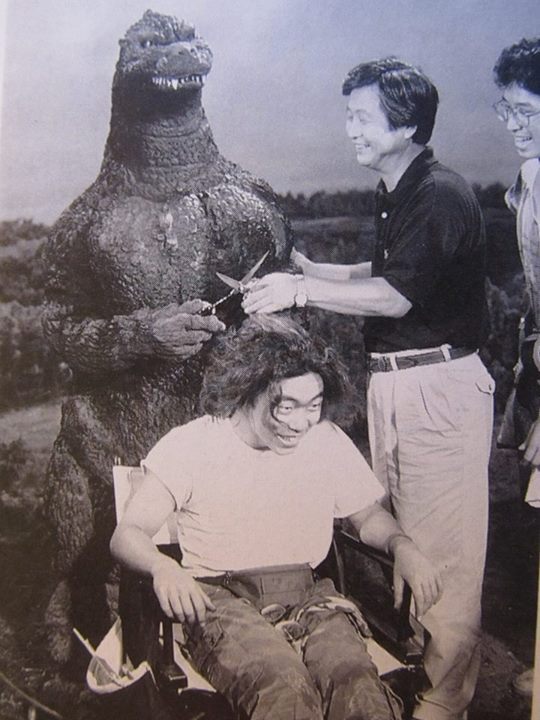
Approaching the Generator (1989-1991) There's a reason this design is so beloved. BioGoji tones down the anthropomorphism of the prior design while retaining its ability to emote. An intimidating, powerful figure, with plenty of bulk, dragon-like countenance, and double rows of teeth, this template would serve Godzilla well for the remainder of the Heisei series with only minor alteration. The main drawbacks are physical rather than aesthetic: with extra mass comes reduction in mobility. This worked fine in Godzilla's more asymmetric battles in the 80s films, but once he started facing peer opponents the stiffness really hampered the choreography.

Erika II (1989) I wish Godzilla vs Biollante had been more successful. If it ways, we might have gotten more creative designs like this instead reheated old favorites for the next few films. While mostly static, Biollante's initial form makes up for it with eerie beauty. I particularly like the little jaws hidden in the flower, hinting at her connection to Godzilla and her following form.
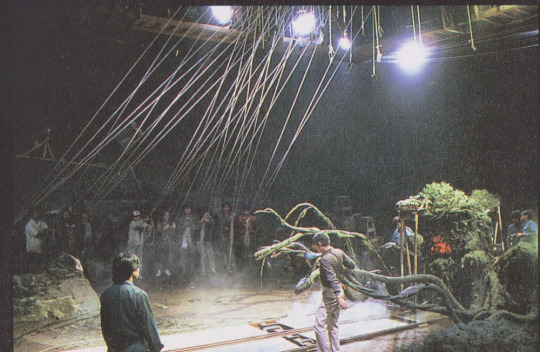
Meaner and Greener (1989) While I wish Biollante had kept more rose like traits in her second form, her design is still wonderfully creative. She is also a tremendous achievement in practical tokusatsu effects: the amount of manpower and coordination that went into making her hulking form move in a convincingly organic way is nothing short of astounding.

The Last Dinosaur (1991) This pre-mutation Godzilla has an interesting mix of dinosaur features. It looks mostly like a retro-theropod, but the larger size and smaller head feel closer to sauropods: I can easily see Godzillasaurus being some form of basal Saurischian. I also like the continuity with his mutated form in the double tooth row and hint of dorsal plates.

GoldenEyes (1992) Most of my points on BioGoji apply to the later Heisei suits, but they all have their subtle variations and tradoffs. BatoGoji's slimmer build improves mobility, but alongside the rearranged plates it results in a less powerful presence. The pronounced ribbing adds definition to the neck, but I'm mixed on whether it fits with the other detailing. The lightened eye color certainly aids in reading emotions, but it lacks BioGoji's fearsome, wine-dark gaze.

Lawd He Comin' (1993) RadoGoji adds back some bulk to the suit, but unfortunately it's more fat than muscle. The shoulders and legs are actually slimmed down, resulting in an awkward, top heavy build. Unfortunately the worst of both worlds.

Super X-2.5 (1993) I can appreciate the idea behind Heisei Mechagodzilla's streamlined, futuristic appearance, but the aesthetic fits poorly with that stubby little tail. I think the design would be improved immensely by a longer, more mobile tail like its organic counterpart. Unfortunately design is even more let down by it's heavily limited mobility: Mechagodzilla's inability to brawl utterly hamstrings the film's fight choreography.
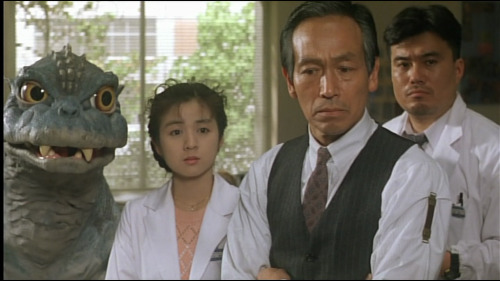
The Blessed Child (1993) This is the right way to handle the Son of Godzilla. Baby Godzilla's large eyes and puppy-like proportions make him undeniably cute, but his realistic anatomy grounds him as a real infant animal. By sidestepping Minilla's human traits, he deftly escapes the uncanny valley.
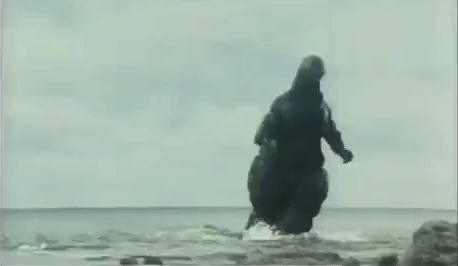
Thunder-Thighs (1994) The final iteration of the BioGoji design returns to some of its roots, with its muscular build, mountainous proportions, and decreased neck ribbing. The face builds on the subtle anthropomorphism of the prior suits though, giving Godzilla a slightly gentler countenance to fit with his increasing sympathetic portrayal in the last few Heisei films. MogeGoji also deserves major credit as the first suit to encorporate ventilation for the performer within.

SuperGodzilla (1994) One of the poster children for elaborate, inflexible Heisei suits: it's a bad sign when the combat form is barely more mobile than the Flying Geode mode. Spacegodzilla at least looks pretty nice, though I think the shoulder crystals are oversized, and I wish the first original Heisei monster since Biollante wasn't so derivative of the original Godzilla.
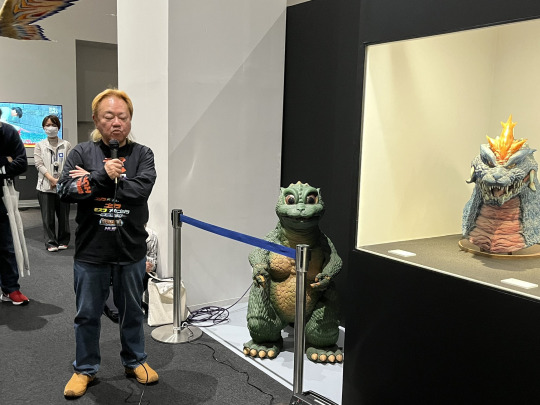
Inverted Ontogeny (1994) Little Godzilla retains the cuteness of his predecessor with his feline visage, but abandons any and all realism for cartoonish caricature. He would be right at home in the Showa era, but feels radically out of place within the established tone of the Heisei series. His intermediate form also breaks continuity with his other two designs, which call for a more organic transition between a subtly cute infant and a more serious adolescent.

GlowstickGoji (1995) A radical visual alteration to the previous suit, DesuGoji's vibrant, lava-like coloration deftly conveys the meltdown he is undergoing. This effect is enhanced by the constant steam, though the carbon monoxide fumes can't have been good for Kenpachiro Satsuma's long term health, particularly considering his tragic death a year ago from interstitial pneumonia.
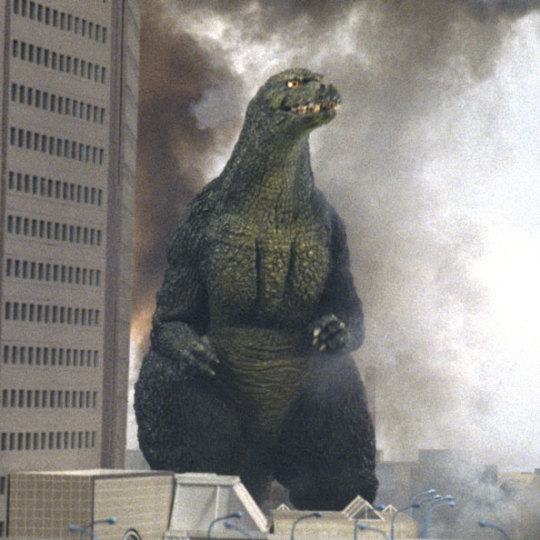
FinalGoji et al. (1995) A welcome swerve back towards realism, though it leaves Little Godzilla as the odd one out. I how Godzilla Junior blends features of his adoptive father's pre and post mutation forms, with his lighter coloration, more horizontal stance, and stubbier dorsal fins.
6 notes
·
View notes
Text
Godzilla Design Runway: Showa
Having finished my film watch, I've decided to make some followup posts going over my thoughts on certain aspects of the films I didn't go over in the retrospective, starting with Godzilla's design over the years, as well as the designs of derivative Kaiju. Photos sourced from Wikizilla.

ShodaiChonki (1954) The first Showa suit is arguably the best, particularly when it comes to detail and physical presence. This extra heft limits the suit's physical capabilities, but it served its role beautifully in the first film as a massive, ponderous beast. The only fault is the mismatch between the puppet and suit designs: despite the former's role in hero shots I think the latter has the more appealing face. It has an iconic dragonish air to it that many later suits homaged, but few truly captured.

Clump Scringly (1955) Similar to the films they appeared in, the second Godzilla suit has all the trappings of the original but little of the substance. GyakushuGoji's gangly proportions and oddly shaped head vacillate between comedic and unnerving. The closeup puppet certainly more alarming, with its gigantic teeth jutting out of the maw.

Simpgoji (1962) One of the more distinctly reptilian takes on the character, with its angular, lizard-like face. While it's not my personal favorite, it works very well as a contrast to the mammalian Kong. It also deserves credit for setting the template for all following Showa suits, simplifying some of the details to hold up better against the rigors of kaiju brawls.

Ol' Grumpus (1964) One of the most iconic suits, popularizing the anthropomorphized look that would define Godzilla for the rest of the Showa period, while still retaining plenty of detail. His talon-like claws provide an interesting contrast to his large eyes and ornery expression: the suit works for both comedy and menace.

Kermit the Kaiju (1965-1966) A fairly middle of the road Showa design. Similar to MosuGoji, but a lot of the finer details were lost in translation. The reduced claws make sense for Godzilla entering his heroic stage, but I miss the more defined expression and facial features from the previous suit.

Dad of Boi (1967) Arguably the worst of the Toho designs. Facial structure is a massive factor in a suit's overall impression, and MusukoGoji's frog-like features are a major flop. It's funny that they deliberately redesigned Godzilla to be more like his son, rather than designing the latter to be less rancid.

The Cursed Child, Part 1 (1967) I've said it before, but a major misstep was trying to make Minilla look like a human infant, rather than something like a puppy or a kitten. The result in a very uncanny design, especially in his larval form.

The Cursed Child, Part 2 (1967-1969) Unfortunately Minilla does not improve much with age. His gigantic brows, bulging eyes, and pig like nose seem to be an extension of Godzilla's ongoing anthropomorphism, but taking the idea to this extreme lands Minilla deep in the uncanny valley. The donkey braying doesn't help.

Old Faithful (1968-1972) The suit with the longest run, SoshingekiGoji stands out among the later Showa designs with it's fierce appearance. It fits well in Destroy All Monsters, where Godzilla is antagonistic for the bulk of the film, but it feels oddly dissonant once Godzilla really starts to embrace his heroic role, though not altogether unwelcome.

Puppy of Justice (1973-1975) The teddybear of Godzilla suits, MegaroGoji is the culmination of the Showa series march towards a more childish tone. It certainly fits its debut film well, with its friendly expression and pillowy dorsal plates. I do think its more serious countenance in the Mechagodzilla duology was a good improvement, giving the heroic appearance a slightly fiercer edge.

Fake Godzilla (1974) The Showa Mechagodzilla is still my favorite iteration of the character, with its harshly geometric appearance, retro charm, and endless arsenal. I also like its disguise's more menacing facial features, though I wish it was more consistently portrayed using the new suit rather than switching between it and MegaroGoji.

The Actual Mechagodzilla 2 (1975) An iterative improvement on the first design, MG2's more angular features and grungier finish suit its movie's darker tone. It also has the honor of being the oldest surviving Toho suit, albeit only in combination with its predecessor's lower half. Of the two, I say I'd prefer the second version over the original, but they are both only slight variations on the same iconic design.
16 notes
·
View notes
Text
Kongwich

Here's an artistic representation of my tonal whiplash watching the last three Godzilla films, featuring an unwise use of Transparent Kongs. It feels like the release order Minus One and x Kong should have been flipped around, so the former released within Godzilla 70th anniversary year while the latter came out in time for King Kong's 90th anniversary. The post production may not have allowed Godzilla x Kong to release earlier, but maybe they'd have saved time if Godzilla was axed from the narrative entirely.
1 note
·
View note
Text
Godzilla Film Watch: Week 6
I end my journey on a Kongwich with Oscar winning filling. Credit to Wikizilla for the poster images. Love Theme performed by the Star Sisters.

Day 36: Godzilla vs Simp (2021) For some reason we as a culture have decided that the natural enemy of the giant gorilla is the nuclear powered dinosaur, and we demand that these action figures be smashed together for our amusement. Because Kong falls on our branch of the amniote clade he is treated with more sympathy, and unfortunately Godzilla must vilified as a consequence. One of Edward's strongest contributions to the franchise was his modernization of Godzilla's heroic role from the later Showa entries: he is more or less indifferent to humans, but saves them in the course of keeping other kaiju in check. Here he's far more aggressive, even in the context of the Mechagodzilla project: I get the sense that Wingard prefers the standard "antihero" characterization, where he crushes mankind and monster alike. Sadly Edwards' sense of scale is also out the window: monsters in excess of 300 feet perform ridiculous feats of strength and agility, while seeming no larger than the men in suits they replaced. CGI can be a powerful tool for conveying the size and mass of daikaiju, but without proper grounding or context it just becomes noise. It's not all bad though. Wingard retains the strong kaiju characterization from Dougherty, even if Godzilla's actual character changed. The fight choreography can be fun in its sheer absurdity, and hollow earth has some creative visuals behind it. Unfortunately the human characters are dealt an even rawer hand than the kaiju, more irreverent dialogue with even less pathos (the fleeting attempt to give the comedic conspiracy nut a tragic backstory is especially baffling). The only effective emotional relationship is between Jia and Kong, and even that required the genocide of the only Skull Island natives with a sympathetic portrayal. This film drowning in flash and starving for substance.

Day 37: Godzilla Minus One (2023) A stunningly beautiful character piece. I've found many prior Godzilla casts enjoyable, even engaging, but I've never felt for them the visceral way I do for Koichi and his found family. Godzilla is just as compelling: Yamazaki accomplishes more than the adjacent films on a fraction of their budget, demonstrating his massive size and strength even at his original scale. I don't think Godzilla has ever been scarier. Yamazaki frames this giant monster's violence from the perspective of characters we deeply care for, as they are directly caught in the crossfire. The results are the most harrowing scenes in the whole franchise, often underlined by Naoki Sato's powerfully chilling score. While the film lacks GMK's direct acknowledgement of Japanese war crimes, it is more consistently successful in its task of dismantling the fascist cult of death which defined much of Imperial Japan. Like Kaneko's film, Yamazaki plays on the conservative framing of Godzilla as vengeance for Japan's forgotten war dead. Here he is twisted into a specter of survivors guilt, who can only be overcome by rejecting this self destructive mindset and fighting for a better tomorrow.

Day 38: Godzilla/Simp: The Frozen Empire (2024) For Godzilla's 70th anniversary he gets a glorified cameo in a Kong movie. His weird little powerup subplot adds little to the film beyond an uglier design: it feels like he overleveled for the final battle, which isn't resolved though strength anyway. It doesn't help that his characterization is the same as the prior film. In Godzilla vs Kong it at least served the narrative: here he is just seems belligerent for no reason. Wingard seems more interested in Kong's story, though he hasn't gotten any better at selling his physical size. Despite his status as the largest incarnation, here Kong feels closer in scale to his 2023 shovelware counterpart: without proper momentum, framing, or reference the great apes feel more like actual gorillas than 80+ meter beasts. The fights can still be fun, but this style worked better with a couple of overheating suit performers than with hundreds of overworked digital effects artists. I liked Suko more than I expected, with his Gollumish antics (his scale compared to the teenage Kong is baffling though). The Scar King also had strong characterization as a despotic bully who coerces Shimo into fighting his battles, but I never bought them as a world ending threat. I think the narrative would be improved by solely focusing on Kong's overthrowing the underground tyrant, ditching Godzilla's side quest and the apocalyptic ramifications. The human characters are somewhat improved—Trapper's carefree hippy routine being the highlight. That said, I've soured on Dr. Andrews and her treatment of Jia: forcing her to attend school in America feels disturbingly close to assimilationist policies throughout colonialist history. The Iwi's demise is walked back at least, though I question the conceit that the Hollow Earth Iwi would share identical culture with the Skull Island Iwi after millenia of separation. They are weirdly reminiscent of the Houta, right down to Trapper's wish that their isolated lifestyle not be compromised by the intrusion of industrial society. This one of the few times the movie articulates something approaching a coherent theme. Wingard's previous film at least touched on the hubris of mankind and its desire for complete control through Mechagodzilla; here even that little bit of substance has drained away.
With that my journey is finally over. We've had some ups and some downs, countless different takes on the character, but I'm still excited to see where the series goes from here. Until then...
Sayonara, Old Friend.

#kaiju#kaiju eiga#godzilla#king kong#mechagodzilla#skullcrawler#warbat#rockclaw#doug#mothra#skar king#shimo#suko#scylla#tiamat#great ape#wartdog#drownviper
0 notes
Text
How Did Godzilla 2 Compare to My Speculation
My first blog post covered the announcement of Godzilla 2 and discussed plausible additions to the monster roster. When the roster was actually released I made a followup post going over the best ways to utilize the cast. After revisiting King of the Monsters last Saturday, I thought I would go over how the final movie held up to those original posts.
I needn't have worried about realism getting in the way of the film. After Rogue One, Gareth Edwards got fed up with Hollywood and left the following films to directors with different opinions on realism in giant monster movies. Dougherty certainly didn't have any problems keeping Mothra a mystical presence, even if the twins aren't tiny anymore. While naturalism is out the window, I lament the decision to make Mothra less cuddly. Her raptorial limbs and wasp like build don't really fit her presentation; I wish they had taken more inspiration from actual Saturniids for something etherial yet adorable.

As I'd hoped, King Ghidorah is the primary antagonist, and thankfully maintains his extraterrestrial origin. Sadly he didn't reach bring all his unique features to Hollywood. The compromise between his classic rayfins and the standard bat wings doesn't really work for me: he's lacking in lower surface area with wings outspread. Weirdly, the traditional ray wings ended up on the Warbats in the next entry. Despite having a perfectly fine bipedal stance, Ghidorah gets forced into the usual quadruped Vermithrax pose despite a lack of any digits not supporting his wing membranes. It's not all bad, he at least retains two full length tails instead of a forked compromise, and his separate personalities is something the character was sorely missing for the previous 55 years.

Rodan is the least radical redesign, though his fire elementalism is ironic considering his original fate. He does have a different role than I expected as part of a tag team with Ghidorah. Mothra and Godzilla are the clear underdogs in their respective matchups, but win through their tenacity and mutual connection with one another, compared to Ghidorah's domination of Rodan through fear. Monsterverse Rodan is a wonderfully fickle kaiju: I love his devious personality and crooked smile. I also can't help but admire Dougherty's little nod to another 50s movie about a flying monster.

My belief that only the Monarch characters should return was also borne out, though neither Serizawa nor Graham survive the film. There's at least something to the new leads this time around, though they're undercut by the hamfisted exposition and lame attempts at humor. I particularly like how despite Mark's vendetta against Godzilla, he can't help but start relating him to the wolves and other wildlife he's spent his life admiring.
1 note
·
View note
Text
Godzilla Film Watch: Week 5
While I could have made this the last week of the watch, I decided to include the anime trilogy in the watch since they did have theatrical releases in Japan. Credit to Wikizilla for the poster images.

Day 29: Godzilla Final Suits (2004) In a twist of irony, the 50th anniversary film is the first Toho entry to cast aside all continuity with the original film, abandoning the partial reboot system that had defined the series since the 80s. Final Wars brings back many old faces, but they are all stripped of their original context, forming a setting as wide as an ocean but as deep as a puddle. The film itself follows suit: Godzilla's quick destruction of his American doppelgänger would have landed better if he didn't mow through the rest of the kaiju cast nearly as quickly (poor Hedorah). The inflated roster must jockey for precious screen time, both with each other and with the excessive human scale fight scenes. Ryuhei Kitamura is a talented director, but I think Kamen Rider would suit him better than Godzilla: here his heavily stylized sensibilities feel out of step with the rest of the series. The more anthropomorphized monster designs such as Gigan and Monster X feel off at 120m, and the extensive wire fu does little to sell their weight. The truncated kaiju fights also feel at odds with the prior films: I think Godzilla works much better as an underdog than an unstoppable juggernaut when facing his peers. The mutant storyline is also a strange place to take the series for its golden jubilee. It starts out somewhat promising, expanding on the Kiryu Saga's themes with the mutant's role as living weapons paired with the EDFs fascist imagery. I think the intrigue following the Xiliens' arrival is the strongest portion of the film, with the subversion of the United Nations institutions and those same fascistic elements. Unfortunately these ideas fizzle out after the Xiliens go mask off, and Ozaki's eventual brainwashing is dispelled by an external tool rather than his internal desire to be more than a weapon. Instead he resolves to not be cattle, replacing the more interesting themes with a generic "indomitable human spirit" message.

Day 30: Godzooky (2014) A decade on, and still nothing quite conveys the sheer scale of daikaiju like Gareth Edwards did. The camera is always set at a human vantage point, with vast spatial depth. CGI is used to give monsters an inertia they could never achieve as people in suits. Godzilla and the MUTOs wade through human structures like they were sand castles and send naval vessels careening in their wake. Some of the later entries approach this sense of scale, even match it occasionally, but none outright exceed it. Beyond the Kaiju, Edwards has a painterly eye for dramatic shot compositions: the HALO jump into San Fransisco is still as fantastic as it was ten years ago. Unfortunately movies are more than just their cinematography. The strongest character is killed off at the end of the first act, and Ford Brody is an unengaging replacement for his father, his only major decision being to destroy the nest. Humanity in general lacks agency in the narrative, including abdication of responsibility for the monsters' existence. Natural disasters can't be controlled, but humans still have a material role in their severity and even initiation, though mitigation measures and anthropomorphic climate change. This film downplays such environmentalist themes, possibly one of the many changes made at the request of military liaison. The US Army now seems to prefer being framed as competent, even if it costs them their monopoly of force, and their positive portrayal robs the film of more biting critique. Still, this film brings a level of subtlety and earnestness to the material that I feel has been sorely missed in the last few Monsterverse films.
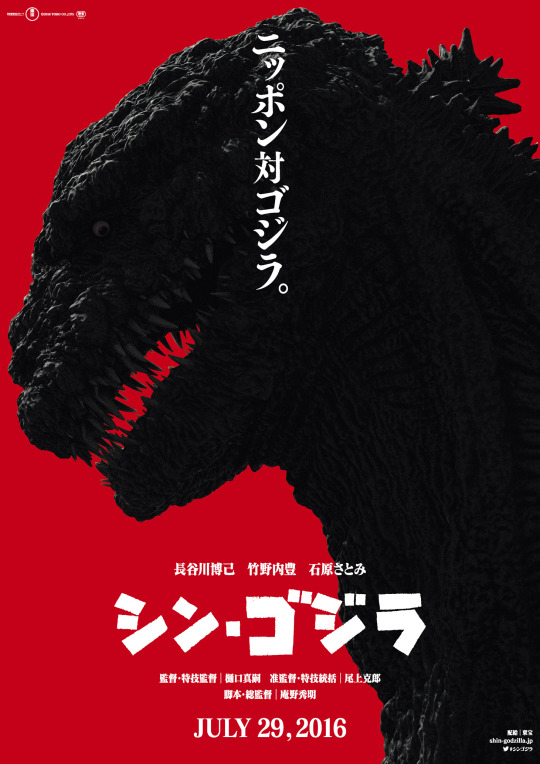
Day 31: Shin Godzilla (2016) This is still such a biting satire. I was once more in favor of bureaucracy, but if the last 8 years have taught me anything, it's that the institutions of power have little interest in doing anything constructive. Anno's cinema vérité camera work and painstaking focus on government logistics fully brings us into this world of bureaucracy while maintaining a dry wit about the absurdism of it all. Godzilla himself is wonderfully unique here, approaching realism from an engineering direction instead of the naturalism of the prior film. Like Edwards before them, Anno and Higuchi excel at using CGI to give weight to the King of the Monsters. Godzilla barely notices his surroundings, but causes mass destruction just by moving forwards, sending massive debris flying with a simple step forwards or an errant flick of the tail. I really like how he evolves towards a more familiar shape as the cast become used to him, before starting to diverge again with the introduction of a terrifying new take on his atomic breath. The pacing starts to drag a bit in the downtime after this pivotal scene—the political satire mostly gives way to the still ambiguous mystery of Goro Maki—but these flaws are paltry in the face of one of the best movies in the whole franchise. The themes are compelling, Sagisu's score is sublime, and the cinematography is masterful. There are so many hauntingly beautiful shots over the course of the film, ending with one that will leave you pondering the film for a long time afterward.

Day 32: Godzilla: Planet of the Monsters (2017) When I first saw this I was pretty whelmed, and that hasn't changed much since. I enjoy the novel take on the series and the world building early on. I especially liked the scene where the Exif and Bilusaludo reflect on their initial plans of conquest, and how they were made irrelevant by the sheer power of Godzilla. Unfortunately this seijin face turn gets rolled back in the following films. Likewise, this film's end twist renders much of the prior plot irrelevant, which doesn't help engagement on a rewatch. Haruo's also not a particularly interesting lead: I've seen people claim he's a discount Eren Jaeger, but his vendetta against Godzilla feels like less of a drive for him than the trilogy implies. His interest in defeating Godzilla seems more in service of retaking Earth than a pathologic obsession in the vein of Ahab.

Day 33: Godzilla: City on the Edge of Battle (2018). The start of this one is a real slog. The Houta are an interesting twist on the Infant Islanders, but the character dynamics among the human cast are pretty weak. Yuko in particular is gets the short end of the stick, with her childish jealousy over Haruo talking to other women, her unwarranted kiss on her stepbrother, and the gratuitous tentacle attack. I do think the movie manages to pull itself together towards the end. The Bilusaludo get some nice development, building off the control obsession established in Terror of Mechagodzilla and adding a fixation on rationalism over morality. Combine this with the properties of the nanometal and we get one of the better Cyberman stories of the modern era. I like how the Bilusaludo don't betray the United Earth so much as their philosophy ends up incompatible with the other members. This culminates in a pretty intense moral dilemma that manages to wring some pathos out of Haruo for once.

Day 34: Godzilla: Planet Eater (2018) The flawed finale to an equally uneven trilogy. Despite Metphies' prominence, the Exif end up a lot more generically villainous than the Bilusaludo: we only see two members, and both are all in on the death cult. I think their human following needed more setup in the prior films, and despite Metphies' claims Haruo ends up pretty accessory in their plot. Ghidorah is a creatively bizarre take on the three headed monster, but past his wonderfully chilling introduction the movie relies too much on telling rather than showing how unnatural he is. The trilogy's sole kaiju battle is also pretty weak: Ghidorah is untouchable for most of the "fight", and puts up little resistance once his invulnerability is gone. The themes are an equally mixed bag. Urobuchi opts for a radical anarchoprimitivist take on the series usual environmentalist themes, positing that the industrial revolution and its consequences will inevitably lead to ruin. I don't think this message fits well with Godzilla Earth's characterization though. Rather than a byproduct of humanity's environmental depredations, Godzilla is personified as a vindictive avenger in the vein of Battra. He deliberately seeks to exterminate mankind as punishment for the hubris of civilization, but given the way he ends up shaping the environment in his own image he comes across as a self-righteous hypocrite. Giving agency to Godzilla's violence makes him unsympathetic, and Haruo's sacrifice to dispel humanity's hatred feels like it's blaming the victim for fighting back against their abuser. It also ends up fulfilling Metphies' desire: by vindicating the Exif's nihilistic beliefs about the arc of all civilization, Haruo essentially submits to Ghidorah after all.

Day 35: Godzilla: King of the Monsters (2019) A glorious serving of fan indulgence, but one with a bit more substance than Final Wars. While I have problems with the Ghidorah and Mothra designs, they more than make up for it with personality. Mothra's scrappy underdog status is endearing, as is her connection to Godzilla, and it shocks me how long it took to give Ghidorah's heads individual personalities. Meanwhile Godzilla carries on his battered old soldier persona from the prior film, while Rodan is a delightfully scrungly little bastard. While I wish Desplat's bespoke themes from 2014 could have carried through the series, Bear McCreary's sweeping renditions of Ifukube's classic leitmotifs more than make up for it. Mothra emerging from the waterfall to a triumphant orchestra playing Her Song was among my most sublime experiences in theaters. Dougherty also makes an admirable attempt at continuing Edwards' sense of scale, though rarely with as much success. His impressionistic use of color is a marked contrast with Edwards' naturalism, but both have an eye for iconic visuals. The human cast are an improvement on the Brodys, but are hamstrung by clunky exposition: everyone has to directly state their current emotions and motivation. Unfortunately the film is also poisoned by the irreverent humor that infests modern Hollywood: occasionally it lands but more often it undercuts the genuine love that went into this production. Dougherty at least manages to push through stronger criticism of the US military's belligerence, even if the lower ranks remain somewhat lionized (never have I seen a more complimentary depiction of the V-22 Osprey). He also wrangles the environmentalist themes into something compelling, rejecting both the passivity of 2014 and the nihilism of the Anime Trilogy. Here humans have a clear role in the changing planet, but have the ability to improve by working with its other inhabitants instead of against them. While this film could have easily fallen into the other Hollywood fixation on "going too far", the end of the film instead presents a clear and positive change in the status quo.
#kaiju#kaiju eiga#godzilla#monster x#gigan#mothra#minilla#rodan#anguirus#king caesar#manda#zilla#kamacuras#kumonga#hedorah#muto#servum#mechagodzilla#king ghidorah#methuselah#scylla#behemoth
3 notes
·
View notes
Text
Pair of Nostalgic Tribute MVs: Part 1.
Apologies for not posting a Film Watch followup last Monday, I had a busy week. Here are some Godzilla tribute videos old enough to drive, though I never got around to learning.
youtube
Goofy little MV set to Brains by Voltaire. It starts as a Tokyo: SOS video before switching to Godzilla 2000, which seems like the more straightforward subject material given the song. One thing that sticks in my memory is the cut to Mothra at 2:44, the head motion as Voltaire sings "I won't Lie" always made me imagine her singing or dancing along to the music.
Continued in Part 2
2 notes
·
View notes
Text
Pair of Nostalgic Tribute MVs: Part 2
I had to split these to embed both videos, in case the copyright bots finally find the YouTube uploads.
youtube
Kiryu focused music video set to Bring Me to Life by Evanescence. Its very 2000s era, but it was probably what introduced me to the idea of kaiju having pathos. Prior to this Mechagodzilla 3 was just the one with the freeze attack who grappled by stabbing you with a lightsaber. It's nice to cast aside Cringe and embrace the more awkwardly earnest bits of your adolescence every so often.
There was also an old Godzilla Junior tribute set to Pain by Three Days Grace, but I have yet to track it down. If anyone has a copy or a link to the youtube video sound off in the comments.
3 notes
·
View notes
Text
Godzilla Film Watch:Week 4
Similar to the prior weeks, we'll be ending on the penultimate Millennium entry. I've ultimately decided to include the American takes on Godzilla, and unfortunately that includes the first attempt at a Hollywood adaptation. Credit to Wikizilla for the poster images.

Day 22: Godzilla vs Destoroyah (1995) The swan song for Heisei Godzilla, and for two men who had shaped the franchise from the very start. Tomiyuki Tanaka returns to the icon he had created for one last film, and Akira Ifukube gives us one final, masterful score, expanding on the leitmotifs he had been developing since 1954. I feel like the characters are handled better than the last few films, and I really like their connections to the original leads. Thematically the film is a massive step up from the rest of the Junior saga, though not without its problems. Destoroyah is great as both a concept and a character design, but it is ultimately a simulacrum: an embodiment of a fictional weapon that was itself an allegory for the potential misuses of science. The buildup carries this theme well: Dr. Ijuin's gung-ho approach is a good foil for Dr. Serizawa's remorse. Unfortunately this theme is undercut by Destoroyah's origin, and its lack of connection to the current Micro-Oxygen research: the repentant scientist is the one that creates the problem. Not helping is the proliferation of unneeded Aliens homages in Destoroyah's early scenes: after a brief hiatus the Hollywood references return in full force. Still, Godzilla's struggle against his own failing body and the demon that murdered both his predecessor and adopted son is genuinely moving, and his final scene still brings me close to tears. The first two Heisei films are overall stronger, but I think the final entry wins out on an emotional level.

Day 23: In Name Only (1998) The longest film in the franchise, yet at no point in its 139 minute runtime does any member of the cast or crew take the material seriously. The humor that plagues this film feels like a precursor to modern blockbusters' aversion to sincerity, but as Hollywood had not yet discovered self awareness Emmerich makes do with a combination of slapstick and caricature. Every actor delivers their lines with a set intonation—never changing to reflect context or emotion—which assists neither pathos nor humor. The Hollywood references continue: Emmerich spends a lot of time aping Jaws and Jurassic Park, but there very little actual Godzilla in his pastiche. Here, the King of the Monsters is a frightened animal, surviving the military through his blistering speed, baffling stealth, and their own stupidity. It seems Hollywood would prefer framing the US Armed Forces as incompetent rather than impotent. There are some attempts to empathize with the monster, but they consist mainly of incongruously uplifting leitmotifs and a rehash of King Kong's death scene from the 1976 remake, immediately undercut by a triumphant celebration. The actual narrative evokes fellow 1954 monster movie Them more than it does the original Godzilla, though it lacks their mutual final warning. Instead of stressing the dangers of continued nuclear tests, the final cliffhanger advises nothing, other than more thorough bombing of civilian areas.

Day 24: Godzilla 2000: Millennium (1999) What a breath of fresh air. I love how the intro to this movie introduces its setting, where Godzilla is a reoccurring natural disaster and is treated as such by society. Our main trio is incredibly endearing, while Mitsuo has such a slick, intimidating presence. The tokusatsu is highly ambitious, with many striking composite shots and a great sense of scale. The fight with Orga is refreshingly physical compared to the later Heisei films, though the final battle leaves the exemplary human cast with little to do for a good chunk of the third act. Fortunately, the denouement is driven by Mitsuo's final, defiant rage.

Day 25: Godzilla vs Megaguirus (2000) While Godzilla 2000 dropped us into an intense opening sequence that organically introduced the characters and world, the actual Godzilla film of the year 2000 opts for a lengthy exposition on the history of Godzilla in this new timeline. While the continuous reboots open up a lot of stylistic flexibility within each Millennium film, here the similarity in approach to the prior film makes me feel like it could have been made stronger through shared continuity. There are some decent character beats, but they have the misfortune of following up one of the strongest casts in the series. Outside of that the G-Graspers feel overly toyetic, and the science behind their plan is some of most absurd in the franchise. The tokusatsu remains highly ambitious, but are undercut by some of the most dated digital effects of the Millennium series. Fortunately this is mitigated by the delightfully comedic final fight. Megaguirus uses her speed to channel Road Runner as she repeatedly trolls Wile E. Godzilla, until her arrogance leads to an ironic end.

Day 26: Godzilla, Mothra, and King Ghidorah: Giant Monster's All-Out Attack (2001) Shusuke Kaneko certainly makes an impression with his sole entry in the series. We get another strong cast of characters, a distinctly memorable score by Kow Otani, and some of the best fight choreography in the Millennium series (Godzilla's brawl with Baragon has a standout mixture of verticality and pro-wrestling moves). It also has among the heaviest themes in the whole franchise. GMK remains the only Godzilla film to acknowledge the crimes against humanity committed by the Japanese military during the Pacific War, something Japanese media rarely tackles. That said, I think this subversive element is at odds with the traditionalist criticisms of Japanese youth. Blaming future generations aligned with the conservative interpretation of the 1954 film, with Godzilla punishing Japan for forgetting the sacrifices of its own military, but it clashes with Kaneko's left wing transformation of this framing. The theme also lacks resolution: Godzilla is defeated by a combination of Shinto Traditionalism and the Japanese Maritime Self-Defense Force, though you could argue the final shot of Godzilla's beating heart suggests this conflict will continue until Japan comes to terms with its past misdeeds.

Day 27: Godzilla Against Mechagodzilla (2002) It's nice to return to Showa runtimes for a bit before the series starts breaking 2 hours reliably. Speaking of Showa, I really enjoyed the twist on the Millennium reboot formula: the incorporation of non-Godzilla Showa films into the timeline gives a nice bit of texture to the backstory. While the humanitarian themes of self actualization aren't nearly as radical as the prior film, I feel they are better incorporated into the narrative through the arcs of our two leads, Akane and Kiryu. This is also where I feel the Millennium effects crew really perfected their particular spin on Tokusatsu. The choreography is once again excellent, the digital effects are better integrated, and the classic atomic breath reaches its final form here. I also enjoyed the twist on the "robot goes berserk" narrative. Rather than the rampaging Mechagodzilla becoming the true villain as in the Monsterverse, they recover him and continue to work on him until he saves Japan from the new Godzilla.

Day 28: Godzilla: Chipwrecked (2003) What a difference a change in writers can make. While the theme that humans should not tamper with nature is one of the oldest in the series, applying it to Kiryu here feels counter the prior film's message that everyone has a right to life, regardless of origin. His reluctance to fight his kin is well established, but there should be options between life as a weapon and freedom in death. Despite the return of continuity, the film still ushers out the prior cast at the beginning. While the new characters aren't bad, they're a lackluster replacement for Akane and the others, though I do like the return of legacy character Shinichi Chujo. Mothra here is the best she's ever looked, and the film retains the strong effects work from the prior entry, despite the change in effects directors. Unfortunately, the early beginning of the main battle causes the pacing to lapse towards the conclusion, particularly when Kiryu is out of commission.
#kaiju#kaiju eiga#monster#monster movie#godzilla#destoroyah#godzilla junior#GINO#orga#megaguirus#meganulon#baragon#mothra#king ghidorah#mechagodzilla#kamoebas
1 note
·
View note